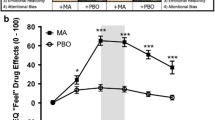Abstract
The discriminative stimulus (DS) effects of smoked marijuana were studied by training marijuana smokers to discriminate between the effects of marijuana containing 2.7% △9-THC (M) and marijuana containing 0.0% △9-THC (P). In addition to measures of discrimination responding, subjective effects were assessed with standardized mood questionnaires. The post-smoking increase in expired air carbon monoxide (CO) level was used as an index of smoke inhalation. Relative to P cigarettes, M cigarettes increased heart rate and produced changes on eight mood scales. M cigarettes were rated as harsher and more potent than P cigarettes, and produced lower levels of CO than P cigarettes. The P-M discrimination was readily acquired by most subjects. The DS effects of marijuana showed a rapid onset, appearing within 90 s from the beginning of smoking. The DS effects were dose dependent, with 0.9% △9-THC marijuana producing primarily placebo-appropriate discrimination responding, and 1.4% △9-THC marijuana producing 100% drug-appropriate responding. This experimental paradigm could be used to determine whether the DS effects of smoked marijuana would generalize to those of other psychoactive drugs.
Similar content being viewed by others
References
Bachman JA, Benowitz NL, Herning RI, Jones RT (1979) Dissociation of autonomic and cognitive effects of THC in man. Psychopharmacology 61:171–175
Balster RL, Ford RD (1978) The discriminative stimulus properties of cannabinoids: a review. In: Ho BT, Richards DW, Chute DL (eds) Drug discrimination and state dependent learning. Academic, New York, pp 131–147
Barry H, Krimmer EC (1976) Discriminative △9-tetrahydrocannabinol stimulus tested with several doses, routes, intervals and a marihuana extract. In: Braude MC, Szara S (eds) The pharmacology of marihuana. Raven, New York, pp 535–538
Barry H, Kubena RK (1972) Discriminative stimulus characteristics of alcohol, marihuana and atropine. In: Singh JM, Miller LH, Laal H (eds) Drug addiction: experimental pharmacology. Futura, Mt Kisco, NY, pp 3–16
Chait LD, Griffiths RR (1982) Smoking behavior and tobacco smoke intake: Response of smokers to shortened cigarettes. Clin Pharmacol Ther 32:90–97
Chait LD, Pierri J (1988) Some physical characteristics of NIDA marijuana cigarettes. Addict Behav (in press)
Chait LD, Uhlenhuth EH, Johanson CE (1984) An experimental paradigm for studying the discriminative stimulus properties of drugs in humans. Psychopharmacology 82:272–274
Chait LD, Uhlenhuth EH, Johanson CE (1985a) The discriminative stimulus and subjective effects of d-amphetamine in humans. Psychopharmacology 86:307–312
Chait LD, Fischman MW, Schuster CR (1985b) ‘Hangover’ effects the morning after marijuana smoking. Drug Alcohol Depend 15:229–238
Chait LD, Uhlenhuth EH, Johanson CE (1986a) The discriminative stimulus and subjective effects of d-amphetamine, phenmetrazine and fenfluramine in humans. Psychopharmacology 89:301–306
Chait LD, Uhlenhuth EH, Johanson CE (1986b) The discriminative stimulus and subjective effects of phenylpropanolamine, mazindol and d-amphetamine in humans. Pharmacol Biochem Behav 24:1665–1672
Davis KH, McDaniel IA, Cadwell LW, Moody PL (1984) Some smoking characteristics of marijuana cigarettes. In: Agurell S, Dewey WL, Willette RE (eds) The Cannabinoids: chemical, pharmacologic, and therapeutic aspects. Academic, Orlando, FL, pp 97–109
Dixon WJ (ed) (1983) BMDP statistical software. University of California Press, Berkeley, CA
Fabian WD, Fishkin SM, Williams HL (1983) Attentional absorption in marijuana and alcohol intoxication. J Abnorm Psychol 92:489–494
Fehr KO, Kalant H (1972) Analysis of cannabis smoke obtained under different combustion conditions. Can J Physiol Pharmacol 50:761–767
Higgins ST, Stitzer ML (1986) Acute marijuana effects on social conversation. Psychopharmacology 89:234–238
Hollister LE, Gillespie HK, Ohlsson A, Lindgren J-E, Wahlen A, Agurell S (1981) Do plasma concentrations of △9-tetrahydro-cannabinol reflect the degree of intoxication? J Clin Pharmacol 21:171S-177S
Järbe TUC, Henriksson BG (1974) Discriminative response control produced with hashish, tetrahydrocannabinols (△8-THC and △9-THC), and other drugs. Psychopharmacology 40:1–16
Järbe TUC, McMillan DE (1980) △9-THC as a discriminative stimulus in rats and pigeons: generalization to THC metabolites and SP-111. Psychopharmacology 71:281–289
Jones RT, Stone GC (1970) Psychological studies of marijuana and alcohol in man. Psychopharmacology 18:108–117
Lindgren J-E, Ohlsson A, Agurell S, Hollister L, Gillespie H (1981) Clinical effects and plasma levels of △9-tetrahydrocannabinol (△9-THC) in heavy and light users of cannabis. Psychopharmacology 74:208–212
Martin WR, Sloan JW, Sapira JD, Jasinski DR (1971) Physiologic, subjective, and behavioral effects of amphetamine, methamphetamine, ephedrine, phenmetrazine, and methylphenidate in man. Clin Pharmacol Ther 12:245–258
McNair DM, Lorr M, Droppleman LF (1971) Manual for the Profile of Mood States. Educational and Industrial Testing Service, San Diego
Mendelson JH (1983) Chronic effects of cannabis on human brain function and behavior. In: Fehr KO, Kalant H (eds) Cannabis and health hazards. Addiction Research Foundation, Toronto, pp 475–500
Ohlsson A, Lindgren J-E, Wahlen A, Agurell S, Hollister LE, Gillespie HK (1980) Plasma delta-9-tetrahydrocannabinol concentrations and clinical effects after oral and intravenous administration and smoking. Clin Pharmacol Ther 28:409–416
Overton DA (1984) State dependent learning and drug discriminations. In: Iversen LL, Iversen SD, Snyder SH (eds) Handbook of psychopharmacology, vol 18. Plenum, New York, pp 59–127
Waskow IE, Olsson JE, Salzman C, Katz MM (1970) Psychological effects of tetrahydrocannabinol. Arch Gen Psychiatry 22:97–107
Weissman A (1978) Generalization of the discriminative stimulus properties of △9-tetrahydrocannabinol to cannabinoids with therapeutic potential. In: Colpaert FC, Rosecrans JA (eds) Stimulus properties of drugs: ten years of progress. Elsevier, Amsterdam, pp 99–122
Young JC, Robinson JC, Rickert WS (1981) A study of chemical deliveries as a function of cigarette butt length. Beitr Tabakforsch 11:87–95
Author information
Authors and Affiliations
Additional information
Offprint requests to: L.D. Chait
Rights and permissions
About this article
Cite this article
Chait, L.D., Evans, S.M., Grant, K.A. et al. Discriminative stimulus and subjective effects of smoked marijuana in humans. Psychopharmacology 94, 206–212 (1988). https://doi.org/10.1007/BF00176846
Received:
Revised:
Issue Date:
DOI: https://doi.org/10.1007/BF00176846




